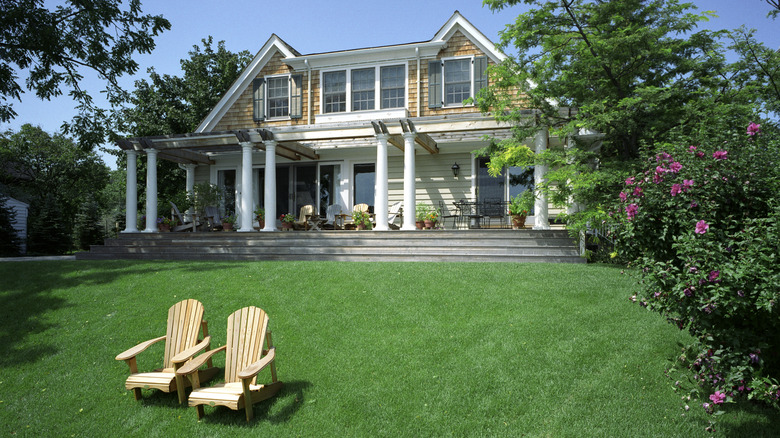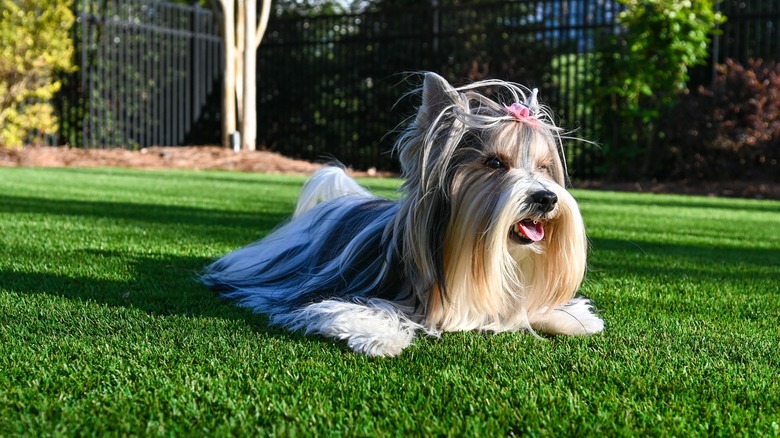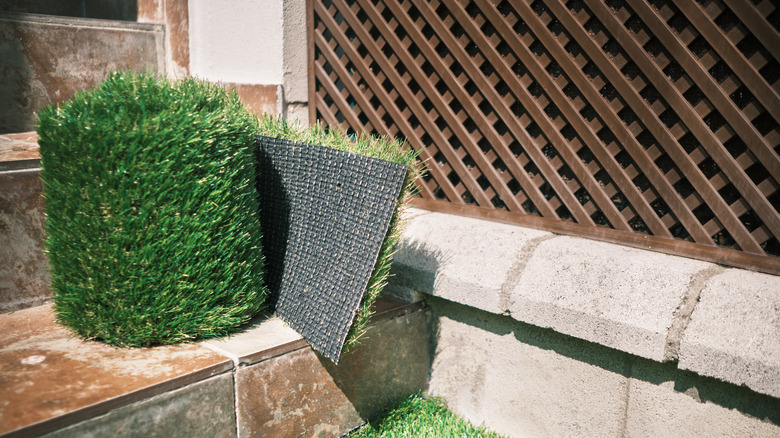The Grass Alternative Taking Over Our Lawns In 2025
The cool, soft feel of grass under bare feet is a summer pleasure akin to enjoying a massive ice cream cone — while you're on a diet. Sure, those treats are hands-down amazing, but they can both bring negative consequences with them. Like a sweet overload that throws your meal plan off for the day, lawns come with water bills, important treatments, and costly maintenance tools that can throw off your bank account. Plus, they require hours of work that you'd probably rather spend in a hammock. These reasons and more are inspiring homeowners to look toward artificial turf that drastically cuts lawn maintenance time. Synthetic lawns save both time and money over its lifetime while also eliminating many of the ecological impacts caused by grass lawns.
If you've been weighing the advantages of synthetic turf vs. natural grass, now is a great time to go for a no-grow solution. The artificial turf of 2025 has moved far beyond the otherworldly green Astroturf we got used to seeing at sports arenas; it's arrived at a high point where it's looking more realistic than ever. While it does cost more at the outset, the payoff over the years — both in time and money — may justify the investment.
There are plenty of pros to artificial lawns
The simplest way to keep your lawn lush and well-manicured is not to have one at all. Gone are the days when artificial lawns glow an unnatural green suitable for a football field. Newer synthetic lawns are designed to mimic the varying colors, lengths, and textures you find in living lawns. Not only does this structure make an aesthetically pleasing product, it also helps the material spring back upright after foot traffic. Once the faux sod is installed, an occasional hose-down and brushing will be, for the most part, the extent of your lawn care. The most work-intensive maintenance you may have to do is giving the surface a proper washing with either vinegar and water or an enzyme-based cleaner.
Manufacturers have also tackled past concerns, like toxins leached from the infill used as a base under the turf, by developing cleaner options. Current designs also drain better than past ones and hold up against heavy wear, including potential problems caused by digging animals. As long as you take care of it, modern artificial turf is equipped to handle weather extremes and extensive sunlight without fading or thinning.
If the initial cost of artificial turf has you rejecting the idea outright, it's not impossible to find companies that offer financing. The right company and interest rate can help you reap the eventual financial benefits of this low-maintenance landscaping without emptying your savings account.
Synthetic lawns do have cons, too
There are still downsides to artificial turf that are worth considering. If you live in an area where lawns go dormant and become crispy, a bold patch of green amid brown surroundings can be a bit jarring to look at. Another trouble spot is that artificial turf doesn't absorb pet urine well. Yet, cleaning this up is not challenging, since a hose-down can do the trick or even spot-cleaning if you're concerned about limiting water use.
The material also has a much higher price tag than grass seed or sod, and installing it is typically better left to professionals. However, high-quality artificial turf that's properly installed and maintained can last between 15 and 25 years. Considering all that goes into a decade or two of lawn care, this amounts to a lot of saved time and cash.
Artificial lawns are more environmentally friendly than grass lawns in some ways, but they aren't an entirely guilt-free product. They're made from nylon, polyethylene, or polypropylene, all of which are plastics. It's also hard (but not impossible) to recycle once it's no longer usable. Older formulas for artificial turf contained hazardous compounds, but that's not a concern with modern products. Since they don't consist of plant material, they aren't a supportive part of the ecosystem, either. One way to reap the benefits of artificial grass while mitigating the negatives is to lay a hybrid lawn with high-traffic areas covered in artificial turf while other parts are treated to traditional sod or other ground covers.


